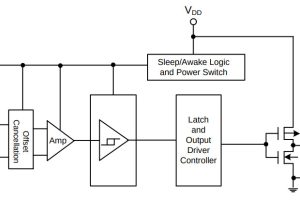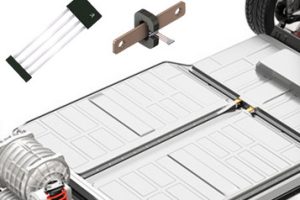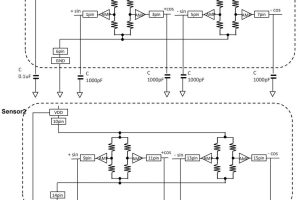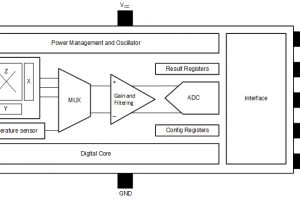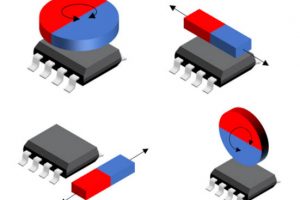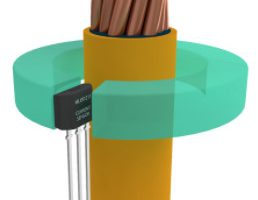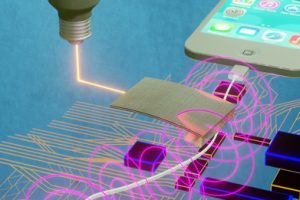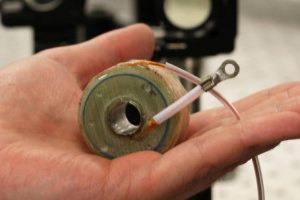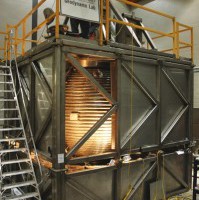Diodes has created a trio of tiny magnetic field triggered sensors that operate from low-voltage rails between 1.1 and 2V. Called AH1899x, they have two power pads and a binary output that is either high or low depending on the local field. Packaging is a 1 x 1 x 0.4mm DFN1010-4. To save power, each includes measure-then-sleep logic and only ...
Tag Archives: magnetic field
ASIL C safety rated mag-field-based current sensor for EV power trains
Allegro MicroSystems has announced an ASIL C safety rated magnetic field beased current sensor for electric vehicle power trains and automotive battery management systems. The company “has developed the ACS37601 programmable linear Hall-effect current sensor IC with over-current, over-temperature and self-test capabilities,” it said. The part “is Allegro’s highest-accuracy field current sensor for applications requiring measurement capability greater than 200A”. ...
Dual redundant magnetic angle sensor for power steering
Alps Alpine is aiming at safety redundancy, particularly in vehicle power steering, with a pair of magnetic angle sensors on two separate die inside the same package, positioned to share the same external magnet. “Redundancy design is increasingly a requirement for automobile driving systems,” according to the company. “The use of multiple sensors was once the typical way of realising ...
3D Hall magnetic sensor is accurate to 2.6% full-scale
Texas Instruments is claiming “industry’s most accurate 3D Hall-effect position sensor” for one that provides 2.6% full-scale total error at room temperature. The first device in a family of 3D Hall-effect position sensors, TMAG5170 is intended for factory automation and motor-drives. Designed for rotational sensing (diagram below), it has three independent Hall sensors for X, Y, and Z-axes backed by ...
3D magnetic sensor measures rotation and translation in many ways
Allegro has created a 3d magnetic sensor that can perform rotary and translation motion measurement both on-axis and off-axis (see diagram). Called A31315, it includes configurable signal processing, linearisation and angle calculation allows it to resolve the absolute rotary or linear position of a moving magnetic target. It has “excellent native angle error over temperature in any plane: <1.2° over -40°C to ...
Hall sensor for measuring currents in automotive
Melexis has introduced a Hall-effect current-sensing IC aimed at cost-sensitive automotive applications: belt-driven starter generators and traction inverters for low-speed electric vehicles, e-scooters, electric forklift trucks and pallet trucks. Called MLX91211, it is used with a ferromagnetic core around a conductor to generate an analogue output proportional to the current flowing in the cable or bus bar. The output signal has a ...
Milliwatts of electricity from mains magnetic field
A tiny diving board can extract power from the magnetic fields around mains cables, according to Penn State university. The device is a magneto-electric-coupled magneto-mechano-electric (ME MME) energy converter that can produce mW power in a 300μT field and operate below 100μT. “Output power from ≤50μT magnetic fields is sufficient to operate a digital clock without charging a capacitor”, according ...
UK universities replace magnetics lab with bench-top test
Super-fast laser sensing has allowed UK researchers to study semiconductors without a magnetics lab. The work will feed into University of Cambridge research on AlGaN/GaN HEMTs (high electron mobility transistors). 30T magnetic coil at the heart of the system, developed by Professor Hiroyuki Nojiri at Tohoku University (see below) The test in question is cyclotron resonance. In a magnetic field, ...
De-magnetising conundrum
I have googled this without finding a satisfactory answer. How long does it take a well-magnetised Alnico magnet to loose magnetism once its keeper/armature is removed? The question arose from a discussion the wise Steve Kurt about removing the armatures from old permanent magnet generators – specifically old Sturmey Archer Dynao Hubs. I vaguely remembered something about the magnet’s own ...
13 tonnes of sodium in hunt for Earth’s magnetic field
At the University of Maryland, Daniel Lanthrop is hunting for the source of Earth’s magnetic field using a scale model of its core. It consists of a smaller stainless steel sphere held at the centre of a larger stainless steel sphere with ~13,500 litres of liquid in between. The smaller one is still pretty large – 1.02m outside diameter, and ...
 Electronics Weekly Electronics Design & Components Tech News
Electronics Weekly Electronics Design & Components Tech News
